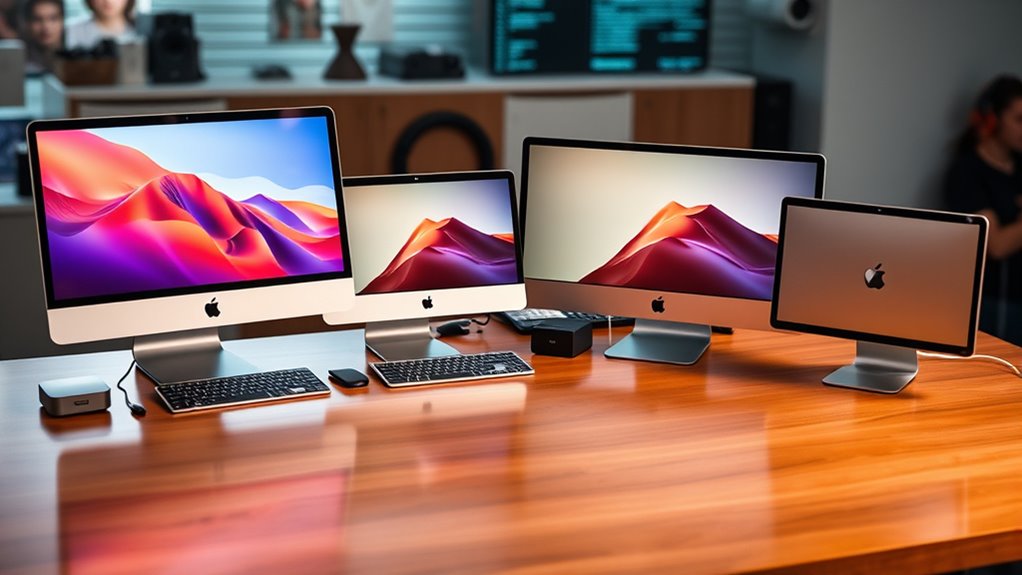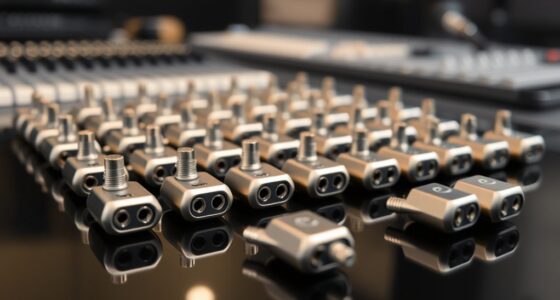If you’re looking to maximize performance in 2025, focus on the Mac Studio with the latest M4 Pro chip for demanding tasks, offering an 12-core CPU and 16-core GPU. The M4 version with 16GB RAM balances power and affordability, ideal for most creative workflows. For heavy multitasking and future-proofing, higher RAM and storage options are essential. Keep in mind connectivity needs like Thunderbolt and Ethernet. Stay tuned—I’ll share more tailored tips to choose the best setup.
Key Takeaways
- Opt for the highest-end M4 Pro or M4 Max chips with maximum CPU and GPU cores for demanding professional workloads.
- Select configurations with 32GB RAM or higher to ensure smooth multitasking and future-proof performance.
- Prioritize models with 1TB or larger SSDs to handle large files and fast data access efficiently.
- Ensure ample Thunderbolt 4, USB-C, HDMI, and Ethernet ports for extensive peripheral and display connectivity.
- Consider futureproofed options with advanced cooling, higher RAM, and multiple expansion ports for longevity and adaptability.
Apple 2024 Mac mini Desktop Computer with M4 Chip
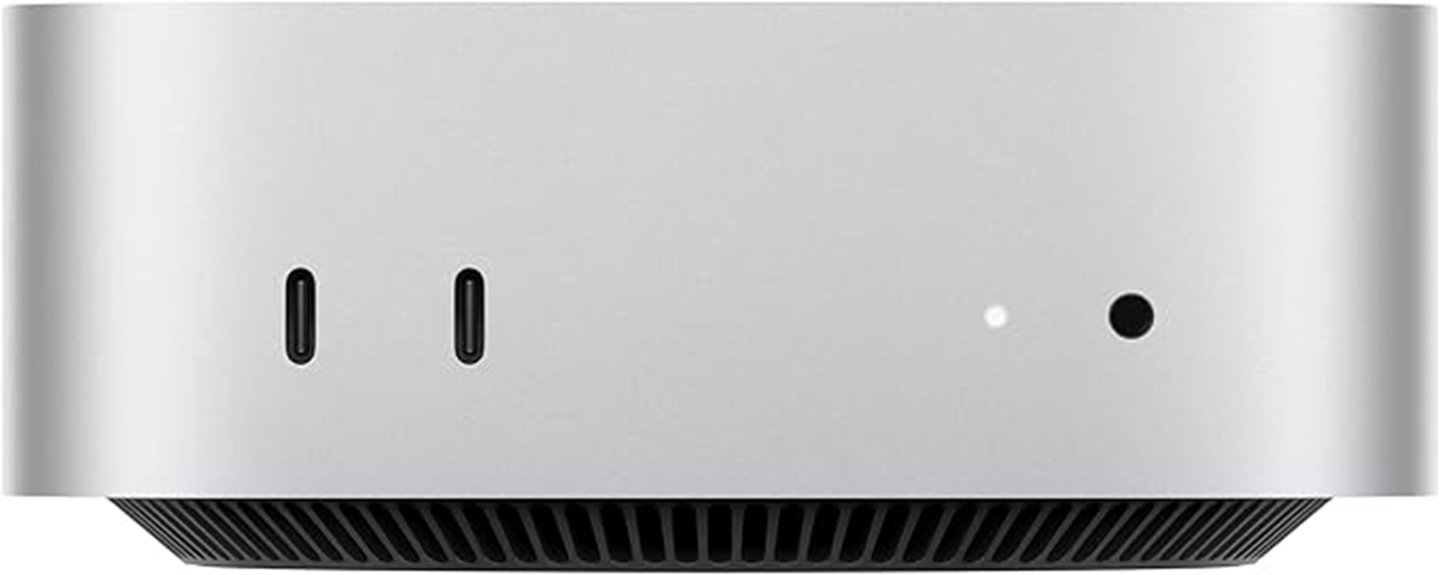
If you’re looking for a compact yet powerful desktop option, the Apple 2024 Mac mini with M4 chip is an excellent choice. Its five-by-five-inch size makes it easy to place anywhere, next to your monitor or in tight spaces. Despite its small footprint, it packs a punch with a 10-core M4 CPU, 10-core GPU, and 24GB of unified memory, which can go up to 32GB. It offers fast storage options up to 2TB SSD and supports multiple high-resolution displays. Quiet, cool-running, and highly portable, this Mac mini delivers impressive performance for creative tasks, multitasking, and everyday productivity—all in a sleek, space-efficient package.
Best For: users seeking a compact, powerful desktop that handles creative work, multitasking, and everyday productivity with ease.
Pros:
- Small, space-efficient design fits easily next to monitors or in tight spaces
- Powerful performance with M4 chip, 24GB (upgradable to 32GB) memory, and fast SSD options
- Quiet operation with minimal noise and efficient cooling
Cons:
- Non-upgradable RAM and storage after purchase
- Limited ports compared to larger desktops, requiring external hubs for extensive connectivity
- Higher price point relative to other compact desktops with similar specs
Apple 2024 Mac mini Desktop Computer with M4 Pro chip
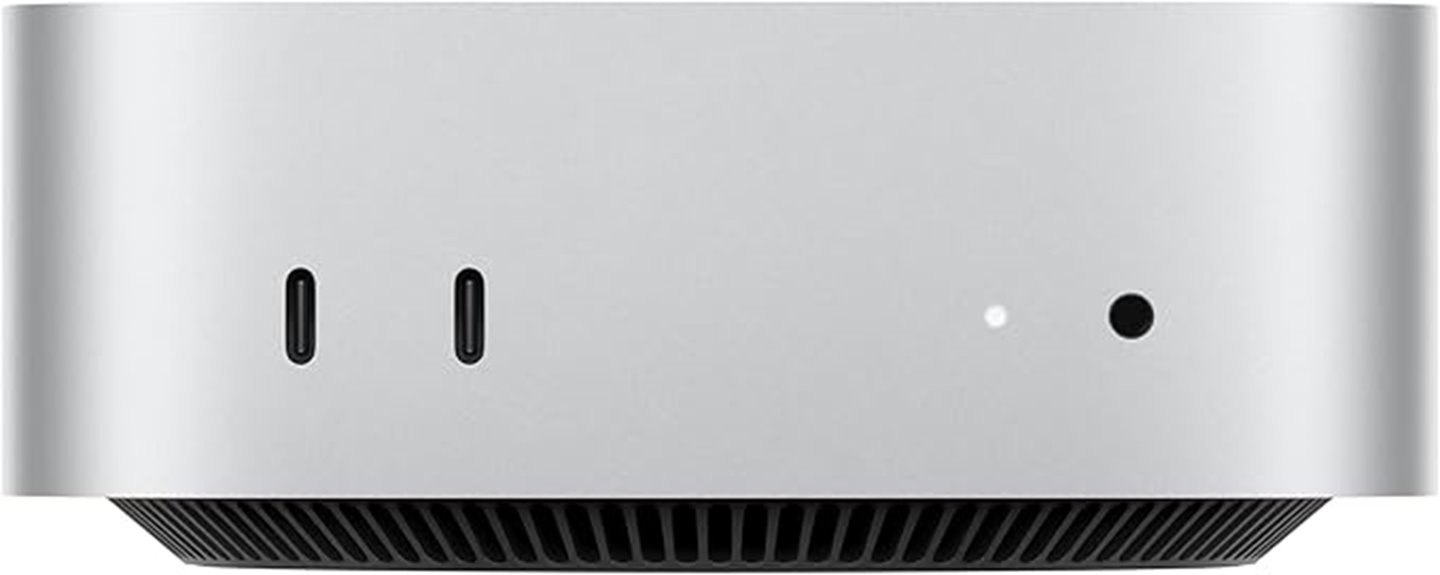
The Apple 2024 Mac mini with the M4 Pro chip is an ideal choice for professionals and power users who need desktop-level performance in a compact form factor. Its small footprint, measuring just 5×5 inches, makes it easy to place next to monitors or anywhere in your workspace. Powered by the M4 Pro with a 12-core CPU and 16-core GPU, it handles demanding tasks effortlessly. With 24GB of unified memory and 512GB SSD storage, it offers speed and capacity for complex projects. Its connectivity options—Thunderbolt, HDMI, USB-C, Ethernet—ensure seamless integration with peripherals. This tiny powerhouse delivers big performance without sacrificing space or versatility.
Best For: professionals and power users seeking desktop-level performance in a compact, space-saving design.
Pros:
- Compact size fits easily beside monitors or in tight workspace areas
- Powered by the advanced M4 Pro chip for demanding tasks and smooth multitasking
- Robust connectivity options including Thunderbolt, HDMI, USB-C, and Ethernet
Cons:
- Limited to 512GB SSD storage, which may require external solutions for large data needs
- Small form factor may limit upgradeability or expandability
- Higher performance comes with a premium price point compared to less powerful mini PCs
Apple Mac mini Desktop Computer with M4 Chip and 16GB RAM
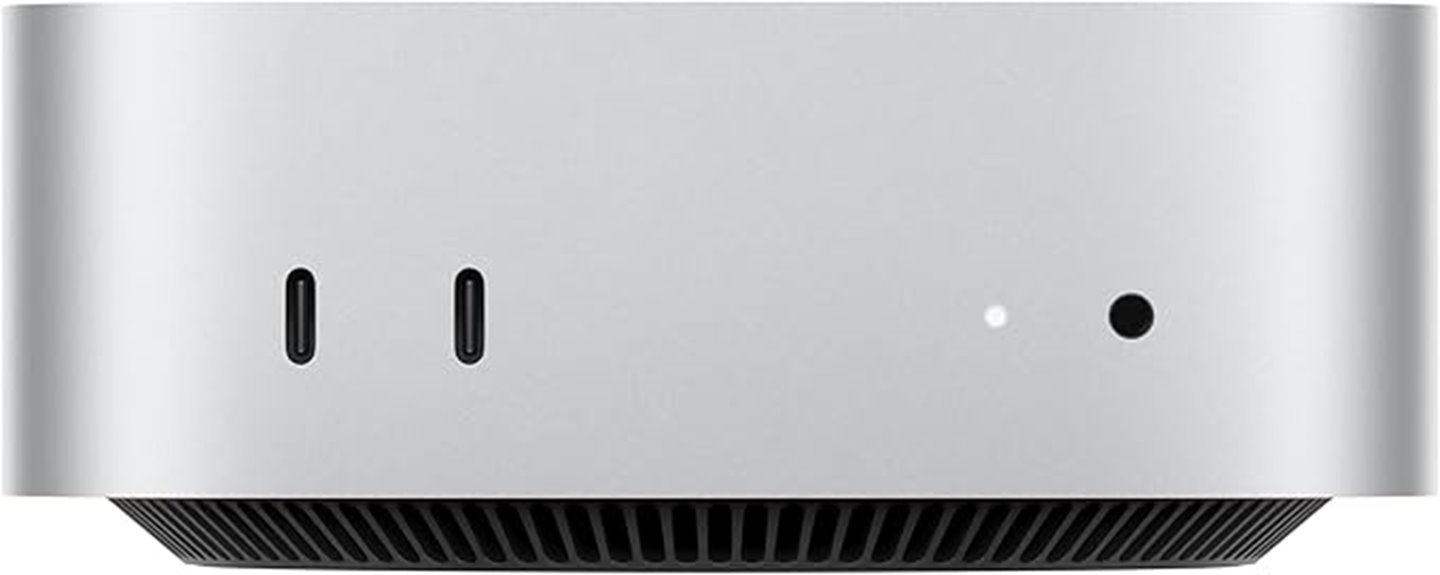
For professionals and power users seeking a compact yet powerful desktop, the Apple Mac mini with M4 chip and 16GB RAM offers an impressive balance of size and performance. Its tiny five-by-five-inch form fits easily next to any monitor, making it perfect for tight spaces. Despite its small footprint, it delivers robust performance with a 10-core CPU, 10-core GPU, and 16GB of unified memory. It supports multiple high-resolution displays and fast data transfer with Thunderbolt 4, USB-C, and Ethernet options. Running quietly with minimal heat, it’s ideal for demanding tasks like video editing, music production, and multitasking—all while maintaining seamless integration within the Apple ecosystem.
Best For: professionals and power users seeking a compact, high-performance desktop for tasks like video editing, music production, and multitasking within the Apple ecosystem.
Pros:
- Small, space-efficient design that fits easily next to any monitor
- Powerful performance with a 10-core CPU, 10-core GPU, and 16GB of unified memory
- Quiet operation with minimal heat generation, ideal for demanding tasks
Cons:
- Non-upgradable RAM and storage limits flexibility for future upgrades
- Limited port options may require external hubs for extensive connectivity
- Price may be higher compared to similarly specced Windows-based mini PCs
Apple 2024 Mac mini Desktop Computer with M4 Chip
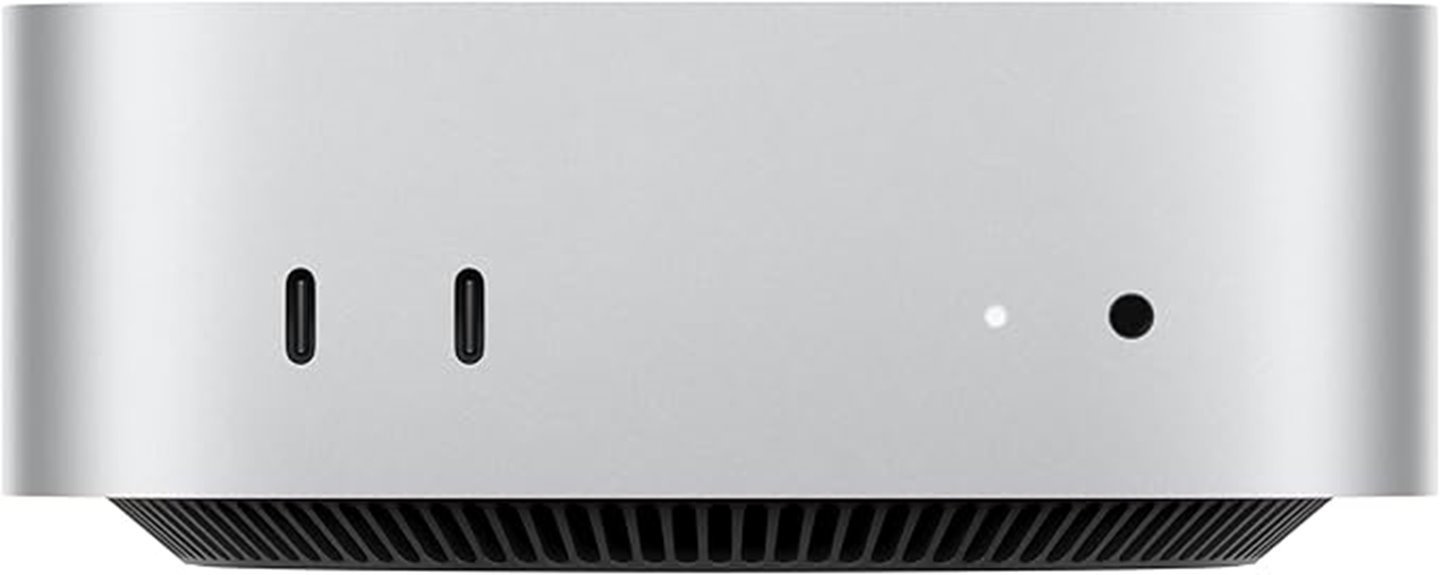
Designed to fit seamlessly into any workspace, the Apple 2024 Mac mini with the M4 chip is the perfect choice for users demanding powerful performance in a compact size. Its five-by-five-inch design makes it easy to place next to a monitor or anywhere in your setup. Despite its small footprint, it packs a punch with a 10-core CPU, 10-core GPU, and 16-core Neural Engine, offering fast app launches and smooth multitasking. With 16GB of unified memory and configurable storage up to 2TB, it handles creative tasks effortlessly. Its quiet operation and excellent heat management make it ideal for professional and everyday use alike.
Best For: users seeking a compact, powerful desktop ideal for creative work, multitasking, and professional applications with space-saving needs.
Pros:
- Small, space-efficient design that easily fits next to monitors or in tight spaces
- Fast performance with M4 chip, suitable for multitasking, media editing, and productivity apps
- Quiet operation and excellent heat management for a seamless user experience
Cons:
- Non-upgradable RAM and storage, limiting future expansion options
- External cables and drives recommended for optimal performance and capacity upgrades
- Limited ports compared to larger desktops, which may require additional hubs or accessories
Factors to Consider When Choosing Mac Studio Configurations
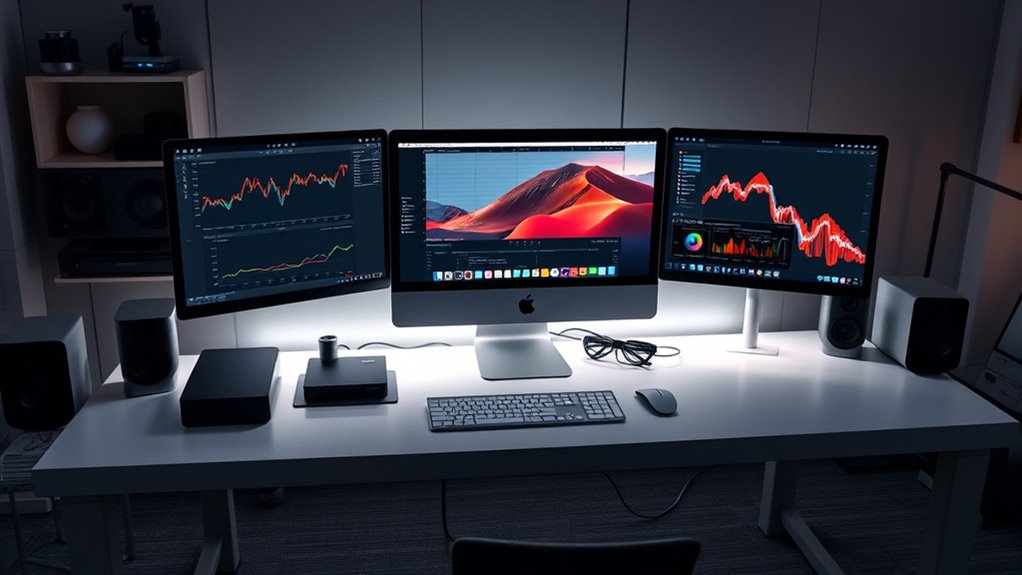
When choosing a Mac Studio configuration, I consider my performance needs first to guarantee it can handle my tasks smoothly. I also look at my budget to find a balance between features and affordability, and I check storage options to meet my files’ demands. Additionally, I evaluate connectivity and display compatibility to make sure everything integrates seamlessly with my setup.
Performance Requirements
Choosing the right Mac Studio configuration depends heavily on your workload’s demands. If you handle intensive tasks like 3D rendering, large-scale video editing, or software development, you’ll need higher CPU and GPU power. Consider whether your applications benefit from the M4 Pro chip and 32GB of RAM to guarantee smooth performance. Evaluate if hardware-accelerated features such as ray tracing, ProRes engines, or AV1 decoding are vital for your workflow. If your tasks are multi-threaded, opt for configurations that maximize core count to boost efficiency. Finally, match your performance needs with storage and expansion options, making sure your setup can handle data transfer rates and workflow complexity. Aligning these factors guarantees a Mac Studio that meets your specific demands.
Budget Constraints
Budget constraints can substantially influence which Mac Studio configuration you end up with, especially when considering options for more RAM, larger storage, or faster processors. If you’re working within a fixed budget, you’ll need to prioritize your core performance needs and avoid overspending on features that may not be essential. Upgrading components like RAM and storage after purchase can be costly, so it’s wise to choose the right specifications upfront. Don’t forget to factor in the total cost of ownership, including accessories and peripherals, which can add up quickly. Balancing your desired performance features with affordability might mean compromising on some specifications. By carefully evaluating what you truly need, you can select a Mac Studio setup that maximizes performance without exceeding your financial limits.
Storage Needs
Evaluating your storage needs is vital before selecting a Mac Studio configuration, especially since internal storage options like 512GB, 1TB, or 2TB are fixed and cannot be upgraded later. I recommend examining your current projects and future requirements—if you work with large media files, high-resolution videos, or sizable data sets, opting for higher internal storage makes sense. External storage solutions like Thunderbolt or USB-C SSDs can supplement internal capacity, but they shouldn’t be the primary solution for large, frequently accessed files. Keep in mind that choosing a higher capacity model increases costs, so balancing your storage needs with your budget is key. Getting the right internal storage at purchase ensures smooth workflow without constant reliance on external drives.
Connectivity Options
Have you considered whether the Mac Studio’s connectivity options will support all your external devices and workflows? It’s essential to verify that it has enough Thunderbolt 4 (USB-C) and USB-A ports for your peripherals. Multiple video output options, like HDMI and Thunderbolt, are important if you plan to connect several high-resolution displays. Also, check that the device offers Gigabit Ethernet or 10Gb Ethernet to meet your network speed needs. Don’t forget audio input/output ports, such as headphone jacks and microphone connections, for your audio peripherals. Ultimately, consider whether your current peripherals are compatible or if you’ll need additional adapters or hubs. Ensuring robust connectivity options helps you maximize productivity without disruptions or limitations.
Display Compatibility
When choosing a Mac Studio configuration, it’s crucial to guarantee it can support the number and resolution of your external displays. Make sure your setup can handle high-resolution monitors like 6K or 5K via Thunderbolt or HDMI ports without issues. Check that the graphics hardware can support advanced features like HDR and Dolby Vision if you need them for your work. Also, verify that the available ports match your monitors’ input types and bandwidth requirements to avoid compatibility problems. Consider the maximum refresh rate and resolution each display can handle for smooth visuals and clarity. Keep in mind that some configurations might require external adapters or cables for excellent performance, so plan accordingly to ensure seamless display integration.
Port Selection
Choosing the right port selection for your Mac Studio is vital to guarantee you can connect all your peripherals and external displays without hassle. Make sure it has enough Thunderbolt 4 or USB-C ports to support multiple high-speed devices simultaneously. Check for HDMI and Ethernet ports, especially if you plan to connect multiple monitors or need wired internet. Confirm the ports support the latest standards like USB 3.2 or USB 4 for fast data transfers with external drives. Consider if there’s a headphone jack or audio output for professional monitoring or casual listening. Additionally, assess whether the configuration allows future expansion, so you won’t need extra adapters or docks later. Proper port selection ensures your setup is both versatile and future-proof.
Futureproofing Goals
Selecting the right Mac Studio configuration involves thinking ahead to guarantee your setup remains capable as technology advances. I recommend choosing higher-spec models with advanced chips like the M4 Pro to stay compatible with upcoming software and heavier processing demands. Increasing RAM to 24GB or 32GB can futureproof your system against evolving multitasking and application requirements. Larger storage options or external drives help accommodate growing data needs and updates over time. Prioritize connectivity features like Thunderbolt 4 and 10Gb Ethernet to ensure your system remains versatile for future peripherals and network requirements. Additionally, investing in robust media engines and hardware-accelerated features will extend your Mac Studio’s relevance for future creative and professional workflows, making your investment more resilient over the years.
Space & Size
The size and footprint of your Mac Studio are key factors to contemplate because they directly impact how well it fits into your workspace. If space is limited, a compact design—around five-by-five inches—can easily sit next to your monitor or in tight corners. Smaller models strike a good balance between space efficiency and hardware performance, but they may have limited internal expansion options. Also, consider the height and cooling design; smaller units often run cooler and quieter, which can be beneficial in quieter environments. Assuring the device’s size matches your setup helps improve ergonomics and makes integrating it with your existing equipment smoother. Taking these factors into account ensures your Mac Studio fits seamlessly into your workspace without sacrificing performance.
Frequently Asked Questions
How Does Upgradeability Affect Long-Term Performance for Mac Studio Users?
Upgradeability plays a vital role in maintaining long-term performance for Mac Studio users like me. When I can upgrade components such as RAM or storage, I extend my device’s relevance and efficiency without buying a new machine. It guarantees I stay ahead with demanding tasks, saves money, and reduces electronic waste. Overall, upgradeability keeps my Mac Studio flexible and powerful over time, adapting to my evolving needs.
What Are the Best External Peripherals to Enhance Mac Studio Performance?
If you want to boost your Mac Studio performance, I recommend high-quality external peripherals. A fast external SSD like the Samsung T7 can speed up file transfers. Pair it with a calibrated 4K monitor for crisp visuals. An external GPU (eGPU) can also give your graphics a significant boost, especially for intensive tasks. Don’t forget a reliable keyboard and mouse to keep your workflow smooth and efficient.
How Does Thermal Management Impact High-End Mac Studio Configurations?
Think of thermal management as the heartbeat of my Mac Studio; it keeps everything running smoothly, especially in high-end setups. When heat builds up, performance drops, and components risk damage. Good cooling acts like a steady rhythm, ensuring my system stays resilient and efficient under pressure. Proper thermal management isn’t just about temperature—it’s about maintaining the harmony that *unlocks* peak performance and longevity in my Mac Studio.
Are There Specific Software Optimizations for M4 Chip-Based Macs?
Yes, there are specific software optimizations for M4 chip-based Macs. Apple’s macOS is designed to leverage the M4’s architecture, ensuring better energy efficiency and performance. I recommend keeping your system updated, as Apple often releases patches that enhance hardware compatibility and performance. Additionally, developers optimize apps for Apple Silicon, so using native apps will give you the best experience. Regular maintenance and updates help maximize your M4 Mac’s capabilities.
What Are the Future Upgrade Prospects for Mac Studio Hardware?
Think of Mac Studio upgrades like a favorite classic song—timeless yet adaptable. Future hardware prospects look promising, with Apple likely to enhance performance through next-gen chips and expanded memory options, much like how a remix elevates the original. I believe we’ll see more powerful GPUs and better connectivity, ensuring your Mac Studio remains a top performer for years. Rest assured, upgrades will keep it ahead of the curve.
Conclusion
No matter which Mac Studio setup you choose, it’s clear that the right configuration can make all the difference in maximizing performance. Think of it like a well-oiled machine—every part working in harmony. By considering your specific needs and future-proofing your investment, you’ll be set to tackle any project head-on. Remember, it’s not just about having the latest gear, but choosing what truly propels you forward.
